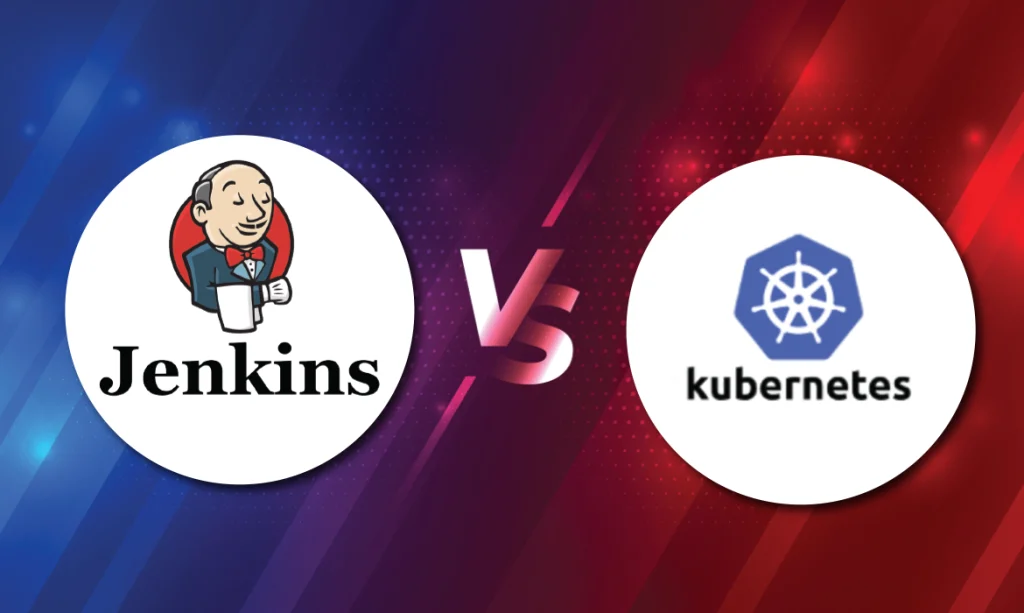Jenkins and Kubernetes are two popular tools used in software development and deployment. Here’s a closer look at some of the key features of Jenkins and Kubernetes:
Table of Contents
Jenkins Features:

Continuous Integration (CI):
It provides a platform for automating the building, testing, and integration of software projects. It allows developers to define a set of steps that should be executed automatically whenever changes are made to the code repository.
Continuous Delivery (CD):
It supports continuous delivery by allowing developers to automatically deploy code changes to testing or staging environments. This process can be further automated to include production deployments.
Plugin Support:
It provides a wide range of plugins that enable integration with other tools, such as version control systems, testing frameworks, and deployment platforms.
Easy Configuration:
It provides an intuitive web interface for managing and configuring jobs, which are the individual tasks that are executed as part of the CI/CD pipeline.
Wide Community Support:
It has a large and active community that contributes to the development of plugins, provides support, and shares best practices.
Kubernetes Features:

Container Orchestration:
It provides a platform for automating the deployment, scaling, and management of containerized applications.
Resource Management:
It manages the resources of the underlying infrastructure, such as CPU, memory, and storage, to ensure that containerized applications run smoothly.
Load Balancing:
It provides load balancing to distribute traffic across multiple instances of an application to ensure high availability and scalability.
Self-Healing: It automatically restarts containers that fail, replaces containers that do not respond to health checks, and reschedules containers on nodes that fail.
Rolling Updates:
It enables rolling updates, which allows updates to be applied to a running application without downtime.
Configurable:
It provides a highly configurable platform that can be customized to meet specific requirements.
Jenkins and Kubernetes are two popular tools used in software development and deployment. While they have some overlapping functionalities, they serve different purposes and can be used together in a complementary way. Here are some key differences between Jenkins and Kubernetes:
Jenkins:
It is an open-source automation server that facilitates continuous integration (CI) and continuous delivery (CD) of software projects. It provides a platform for automating the building, testing, and deployment of software projects. It allows developers to define a set of steps that should be executed automatically whenever changes are made to the code repository.
Jenkins provides a web interface for managing and configuring jobs, which are the individual tasks that are executed as part of the CI/CD pipeline. It also provides plugins for integrating with other tools such as version control systems, testing frameworks, and deployment platforms.
Kubernetes:
The deployment, scaling, and maintenance of containerized applications are all automated via the open-source container orchestration technology known as Kubernetes. It provides a platform for running and managing containerized workloads across a cluster of nodes.
It allows developers to define a desired state for their application, and Kubernetes takes care of deploying and managing the containers that make up the application. It provides a powerful set of features for managing containerized workloads, including load balancing, scaling, self-healing, and rolling updates.
Related:- Hyper V vs. VMware ESXi : Which is better ?
Key Differences:
Purpose:
Jenkins is primarily used for automating the building, testing, and deployment of software projects, while Kubernetes is primarily used for deploying and managing containerized applications.
Architecture:
Jenkins is a standalone automation server that can be installed on a single machine or a cluster of machines, while Kubernetes is a distributed system that runs across a cluster of nodes.
Scope:
Jenkins is focused on the CI/CD pipeline, while Kubernetes is focused on the management of containerized workloads.
Flexibility:
Jenkins is highly customizable and can be configured to work with a wide range of tools and technologies, while Kubernetes provides a more standardized platform for running containerized applications.
Learning curve:
Jenkins has a relatively low learning curve and can be easily set up and configured, while Kubernetes has a steeper learning curve and requires more effort to set up and configure.
Conclusion:
While Jenkins and Kubernetes have different functionalities, they can be used together to create a complete CI/CD pipeline for containerized applications. For example, Jenkins can be used to build and test container images, while Kubernetes can be used to deploy and manage those images in a production environment.









